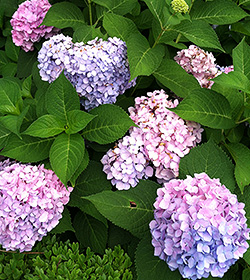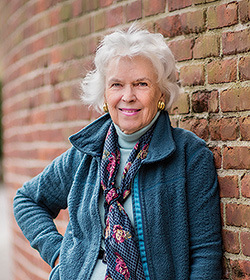NYBG’s Hydrangeas Are In The Pink
Posted in Horticulture on August 6 2014, by Sonia Uyterhoeven
Sonia Uyterhoeven is the NYBG’s Gardener for Public Education.

Earlier this season, Todd Forrest posted a blog entitled “Waiting for Hydrangeas”. He spoke of the cold spring we had where temperatures plummeted below freezing, destroying many hydrangea flower buds that were waiting to bloom this season.
While panicle hydrangeas (Hydrangea paniculata) and smooth hydrangeas (Hydrangea arborescens) flower on new wood, the bigleaf, mophead, and lacecap hydrangeas (Hydrangea macrophylla) that we all adore, flower primarily on old wood with the flower buds forming the previous season.
The re-blooming or remontant type that flower on both old and new wood have, as predicted, fared very well. We have a large planting of Endless Summer® at the train station entrance of the Garden at the Moshulu Gate. It has been flowering beautifully for the past month with new flowers starting to form as older ones fade. The first year these hydrangeas were planted the flowering was sparse, but now that they have established a solid root system and settled in they are floriferous.

Some of the once-blooming varieties have also been flowering from buds that were unscathed by the late frosts, but not as vigorously as they have in previous years. Last year, I had toured around the Home Gardening Center with Lynden Miller, discussing some of her favorite varieties and admiring a collection of hydrangeas that she had donated from her own garden.
A number of her favorite hydrangeas are producing blooms this year and looking lovely in the Home Gardening Center. For those of you who have a penchant for lacecap hydrangea, a selection named ‘Tokyo Delight’ is covered with blooms. ‘Tokyo Delight’ is—as described—a delight.
Lacecap hydrangeas have flattened flower clusters or corymbs that contain tiny fertile flowers in the middle and large sterile flowers on the margins. ‘Tokyo Delight’ fertile flowers are a soft pink and the sterile flowers start out vibrant white. As the flower ages the color gradually deepens to a darker pink. The two-toned effect is spectacular and the colorful display is heightened in the fall with foliage that morphs from russet to purple.
While ‘Tokyo Delight’ is often listed as Hydrangea macrophylla, Michael Dirr lists this hydrangea as a cultivar of Hydrangea serrata. Hydrangea serrata are indigenous to the mountainous regions of Japan and tend to be more cold tolerant than bigleaf hydrangeas. This hydrangea (whether macrophylla or serrata) has proven to be cold tolerant.
One of my favorites from Lynden’s collection of hydrangeas is ‘Merritt’s Supreme’. It is a mophead hydrangea with a large round head. ‘Merritt’s supreme’ is a compact plant with thick stocky branches, which give it a nice habit. The flowers steal the show. They are jumbo-sized mopheads that open up a creamy color and then change in our garden to a brilliant, rosy pink. The color varies depending on the soil pH—they have a lilac to lavender-pink hue in more acidic soils.
‘Brestenberg’ is another selection that is flowering this year with lavender-pink blooms in our garden. This hydrangea will be blue in acidic soil and pink in alkaline soil. In reaches a happy medium in our bed with an infusion of both colors. The mophead is so jam-packed that the petals curl upwards like little teacups.
The final selection that I would like to mention today is right at the entrance of the Home Gardening Center. It is named ‘Blaumeise’ but it is also synonymous with ‘Blue Teller’ or ‘Blue Tit’. The name ‘Blaumeise’ or ‘Blue Tit’ comes from a small European bird with the same name. This is one of the best blue lacecap hydrangeas in the trade these days. It is a Swiss ‘Teller’ hybrid. While this selection does not have the reputation for being frost tolerant, it has done well this year considering the odds.
In our soil, ‘Blaumeise’ is an attractive mix of mauve and cobalt blue. The color may change over time as the plant continues to settle into its home. This selection will be bluer in acidic soil and have the blue/mauve tones in alkaline soil. If you are in the market for a pink lacecap hydrangea, its counterpart is called ‘Fasan’ (meaning pheasant) or ‘Red Teller’. It sports rose-red florets.
Some of Lynden’s favorites in the garden, such as the spectacular ‘Madame Emile Mouillere’ with its white hortensia or mophead flowers, its pink or blue eyes and pure white petals that start to blush pink in the fall, are sadly very quiet this year. There will always be next year and gardeners learn how to weather the whims of Mother Nature. Next week we will continue our conversation about hydrangeas looking more at flowering, care and color.


really enjoy reading your posts they are always so informative and well illustrated….